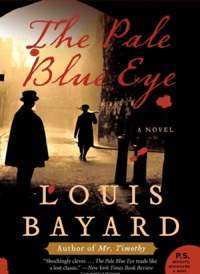
BGH Book Club: The Pale Blue Eye
Writing this past August in my review of "Mirrors," I linked the mystery and horror genres as structural siblings — literary kissing cousins, if you will. The overarching point was that in both types of film there's something hidden or unexplained that an inquisitive soul — who we could call the detective — tries to explore or explain away. Now that's certainly not to say that all horror films follow this basic premise, but just this year we've seen several including "Shutter," "Saw V," the aforementioned "Mirrors," and to a lesser extent, films like "Quarantine" and "The Happening."
While not genetically inseparable from one another, horror and mystery clearly share many traits, which means it should come as little surprise that many mystery writers veer toward the macabre and horrific when crafting their stories. The inciting incident for a vast majority of mysteries is a murder, though sometimes also murder's ill defined partner, "a disappearance." And it is from this snuffing of human life that mystery writers extrapolate a world of death, danger and violence. In "The Pale Blue Eye," the excellent fourth novel from Louis Bayard, we find all these trappings of mystery, but we also find a good deal more, and much that treads almost giddily into the realm of horror.
The action of "The Pale Blue Eye" takes place in the upstate New York of the 1830's. More specifically, the novel follows an investigation into a series of deaths on the campus of West Point Military Academy. Gus Landor, our protagonist and a former New York City police officer turned local retiree, is brought to the campus discreetly by the commandant of the academy. As the commandant makes clear very early on, the profile of West Point was vastly different in the first several decades after the founding of the U.S. There was much debate about the value of a national army, and even more debate about the value of a school to train soldiers who would be loyal to a federal government. These murders, though thought to be unrelated to the actual military, threaten to undermine the academy's long term hopes of survival. This is largely political theater that we know to be immaterial to the investigation at hand (if only because West Point still exists), but it provides an interesting backdrop for the unfolding of Bayard's tale.
In the opening pages, a murder of such bizarre and disturbing proportions is laid bare and a tone of morbidity and death is set. "Lazarus began stinking after a few days — why should Leroy Fry have been any different?" It's with these words that we are introduced to the victim. They are typical of the way that Bayard, who writes largely from detective Landor's POV, describes the gloomy surroundings.
If there was ever any question about Bayard's commitment to crafting a mystery that also pays homage to the darker genre, the speculation ends when he introduces Cadet Fourth Classman Poe — that is, Edgard Allen Poe. Lest it seem a gimmicky ploy, one should remember that Poe had actually matriculated to West Point in July of 1830, and thus Bayard's premise, that Poe becomes a sidekick of sorts to observe Landor's investigation, is at least plausible given the time frame. Throughout the novel Bayard makes other allusions and references to aspects of Poe's life that appear to have been well researched.
The seemingly odd choice to incorporate a real historical writer is also important as Poe is credited with creating the first literary detective, C. Auguste Dupin, as well as fictional detective story, "The Murders in Rue Morgue." As the founding father of detective fiction, Poe himself has appeared in various other novels, occasionally even as the primary detective.
While Poe does indeed become a central player in the plot of "The Pale Blue Eye," he also serves as a foil for Landor and something of a literary device for the writer, allowing him to deconstruct some of the tropes of detective fiction as well as some of the elements that would later become famous in Poe's horror fiction. The creation of a fictional Poe in the book seems almost too novel to work, but it does because Poe is just another character, and though he is lovingly constructed, he comes with desires and imperfections that never seem unnatural.
I won't tread into the actual plot of the book because I think it is very much worth a read, but among true mystery novels, "The Pale Blue Eye" is one of the darker that you'll find. There are moments of violence and gore, and even more speculative evils, such as Satanism. It's a richly narrated tale that fully evokes a time period not often encountered in fiction. And while Bayard's plot never quite broaches the supernatural, there are moments when the action will force you to think about how many of the things that we take for granted may well have seemed like sorcery or evil to those in the 19th century. Most of all though, "The Pale Blue Eye" succeeds because it manages to do what many horror movies or stories fail to do: it keeps its secret hidden until that point where it has created the most possible suspense, and then it lets it all rush out at you. The reason that it succeeds where many fail is because when its secrets are revealed, their impact is not diminished.
Next time at BGH Book Club: Come Closer

